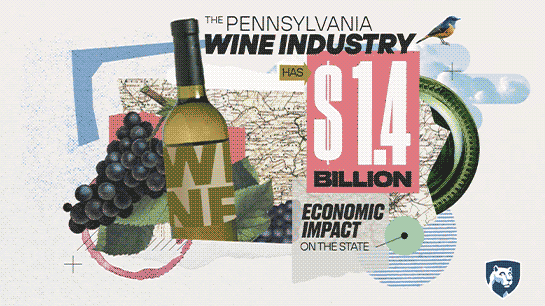Every glass of wine tells a story.
A story of climate, soil, vines, buds, grapes, and a host of challenges along the way from vineyard to glass.
The Penn State Grape and Wine Team—a group of viticulturists, plant pathologists, entomologists, enologists, sensory scientists and marketing specialists—works to create success stories for Pennsylvania’s $1.4 billion grape and wine industry.
With some of the most fertile grape-growing land on the East Coast, Pennsylvania ranks fifth nationally in grape yield and seventh in wine production. More than 14,000 acres of grapes are harvested and made into two million gallons of wine each year, and more than 300 independent wineries throughout the state depend on the industry’s success.
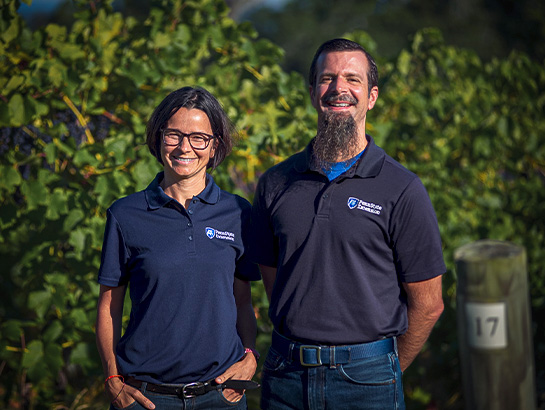
Michela Centinari, associate professor of viticulture, College of Agricultural Sciences
Cain Hickey, Extension Educator (Viticulturist)
The Penn State Grape and Wine Team
A group of viticulturists, plant pathologists, entomologists, enologists, sensory scientists and marketing specialists in Penn State's College of Agricultural Sciences and Penn State Extension.
“Penn State’s approach to this problem is interdisciplinary; we have many people across different departments working on these projects. I focus on the grapes. Our food science colleagues work on the wine side, on the taste. We also work with entomology.”
—Michela Centinari
Securing Winemaking’s Future
Growing wine grapes isn’t always easy, regardless of region, and Pennsylvania is no exception. Because of the state’s cold winters and humid conditions, some grape varieties grown in other regions of the country aren’t well suited for the Northeast. Pennsylvania growers need to select varieties that will produce quality fruit, and wineries need to make smart decisions about marketing and promotion to appeal to consumers.
Penn State’s research on grape production addresses concerns across the entire wine supply chain from grower to consumer, providing guidance on topics ranging from how best to grow grapes and ensure a profitable yield to which varieties are most suitable to the regional trends in consumer tastes and preferences.
A major research effort underway focuses on the spotted lanternfly and how it damages grapevines. “This is a multidisciplinary project because it’s a complex problem,” said Michela Centinari, associate professor of viticulture. “Growers don’t know how the lanternfly will affect their grapevines because it’s a relatively new pest and we have limited information about it. So our researchers are studying the insect, the plant, and the effects on wine.”
Part of the spotted lanternfly research focuses on economics. Along with Flor Acevedo, assistant professor of entomology, Centinari is working to assess economic decision levels to determine what number of lanternflies will cause a decline in vine health and growth for two popular varieties—Chardonnay and Cabernet Franc.
“This number will be a critical threshold for growers because it determines when a grower needs to use control tactics to reduce insect populations,” said Acevedo, who is based at Penn State’s Lake Erie Regional Grape Research and Extension Center. “Controlling this insect can be expensive so it’s an important economic decision.”
“This number will be a critical threshold for growers because it determines when a grower needs to use control tactics to reduce insect populations… it’s an important economic decision.”
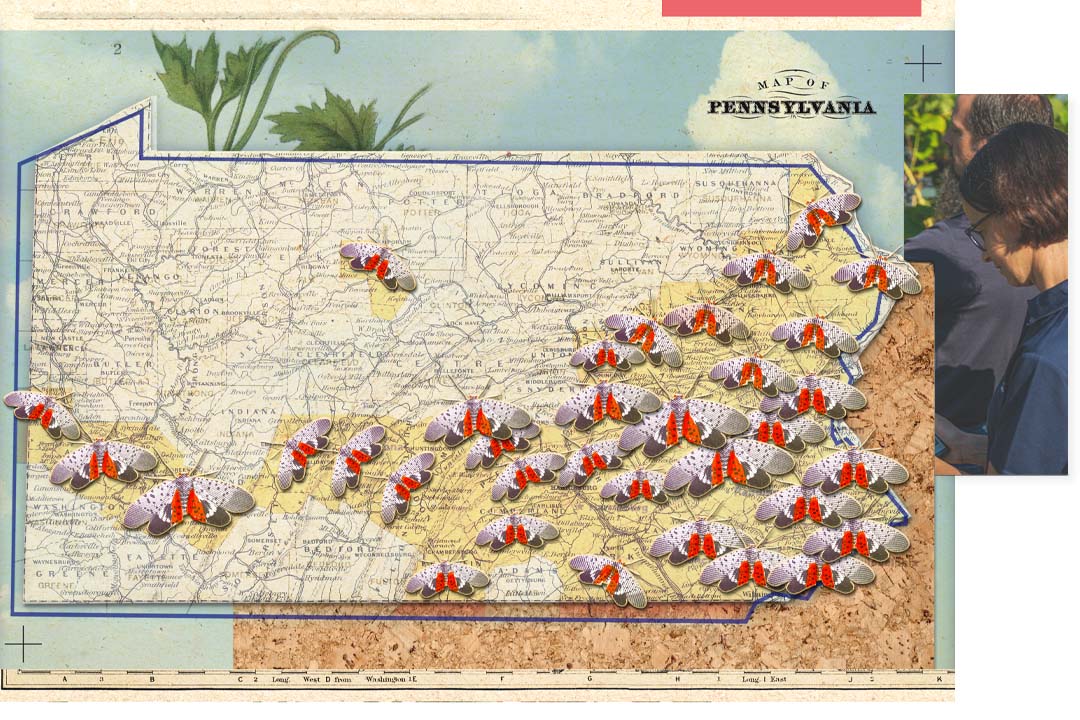
Growing New Techniques Together
In addition to new concerns like the spotted lanternfly, Penn State researchers are finding ways to maximize Pennsylvania grape harvests.
Frigid winter weather and fluctuating temperatures in early spring can damage vines, resulting in poor growth and low grape yields. The team works with growers on affordable techniques they can use for delaying bud break—when the vines develop fragile new green shoots. These techniques include applying vegetable-oil-based products to the bud as well as pruning practices.
Improving soil health can also lead to growing better grapes. Agricultural economist Claudia Schmidt is conducting a budget analysis to estimate the costs and revenue associated with different soil management practices, one of which is using cover crops in the vineyard—a sustainable approach that can reduce herbicide use and help control erosion. Now in its fifth year, the project has proved successful for some growers, and the team hopes more growers will adopt the practice.
“It can be hard to adopt a new practice, but saving money can be a powerful incentive,” said Centinari.
While these techniques can ultimately lead to cost savings, the team understands that the investment can deter growers. Understanding that implementing these new methods may appeal to consumers, Kathy Kelley, the team’s marketing specialist, is exploring if shoppers would be willing to pay slightly more for a bottle of wine made with sustainably grown grapes.
“Our work, along with the resources of a land-grant university, makes people start to take notice. The collaboration between Extension and industry stakeholders makes the future hopeful.”
—Cain Hickey
Moving the Industry Forward
Research is just one component of the Grape and Wine Team. Equally important are the team’s educational and outreach efforts. Undergraduate and graduate students work side-by-side with researchers to gain real-world experience while extension educators champion workshops, social media, videos, and articles to share real-time information with audiences around the world.
Viticulture extension educator Cain Hickey spends his time sharing research-based and commercially relevant information by visiting vineyards and holding workshops, as well as writing articles and sharing news on social media.
“Extension is where theory and practice collide,” Hickey said. “Agriculture is an applied science, and we work to get that research-based information out there to benefit the widest range of stakeholders possible.”
A new way of disseminating timely information is the Cultivars in the Commonwealth app, an interactive web application that provides data on grape varieties grown throughout Pennsylvania, information on how each variety is performing in each county, and consumer demand.
“Vineyards are perennial,” Hickey explained. “You plant them once and hope to get at least 20-30 years of production out of them. When it comes to choosing a cultivar, or variety, it is a complex decision and it can be hard to even know where to start. This [application] empowers growers to choose the traits that are important to them.”
About 60 grape growers from across the state entered information about all the cultivars they’re growing, including disease resistance, cold tolerance, crop yield, fruit maturity, wine quality, and sales trends. Users of the app can click on a specific county or cultivar to access the information at a glance, giving growers access to timely information for every stage of the season.
From field and marketing research to education and extension, the key to the team’s success is its interdisciplinary approach. “It’s a great opportunity to be able to communicate with other departments and access such a wide variety of expertise,” said entomologist Acevedo. “We serve as a source of ideas and motivation for each other. I don’t know if we’d have such an opportunity at any other university.” ■
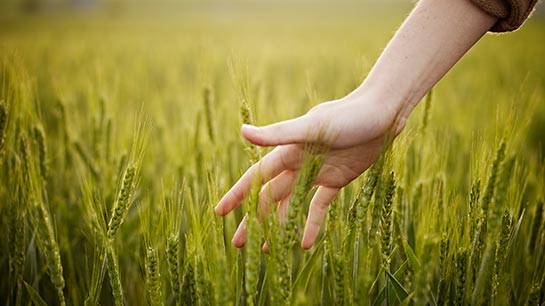
Penn State Extension is a modern educational organization dedicated to delivering science-based information to people, businesses, and communities. Extension provides access to face-to-face and online education to our customers—when they want it, where they want it, and how they want it—to help them address problems and take advantage of opportunities for improvement and innovation. Partnering with and funded by federal, state, and county governments, Extension has a long tradition of bringing unbiased support and education to the citizens of Pennsylvania. Extension makes a difference locally through focused engagement, and more widely to customers connecting in the digital landscape.
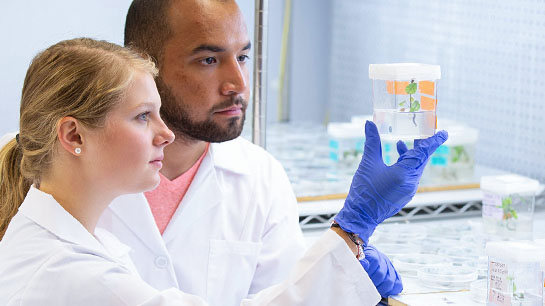
The College of Agricultural Sciences is a world leader in agricultural research and learning, driving discovery and solutions that make life better. From our 1855 start as the Farmers’ High School, agriculture has been at the core of the Penn State mission and identity. Today, the best and brightest teach and learn with us at campuses across Pennsylvania and in locations across the planet.
Support for the Grape and Wine Team’s initiatives comes from the Pennsylvania Wine Marketing and Research Board; the Pennsylvania Liquor Control Board; Pennsylvania Department of Agriculture; Multistate Regional Research appropriations; Extension and Smith-Lever appropriations of the National Institute of Food and Agriculture, U.S. Department of Agriculture (USDA); USDA National Institute of Food and Agriculture Specialty Crop Research Initiative and Foundational Program; the New York Wine and Grape Foundation; and the Northeast SARE research and education grants.



